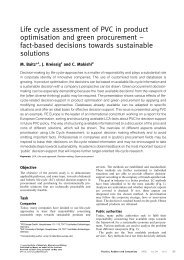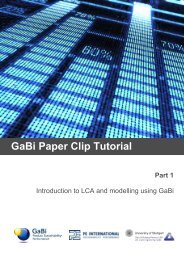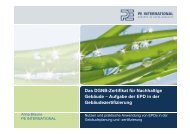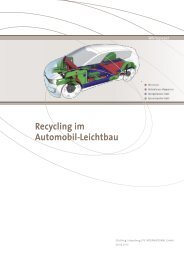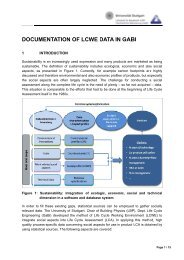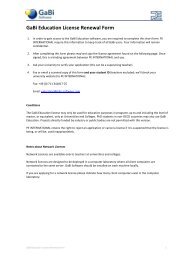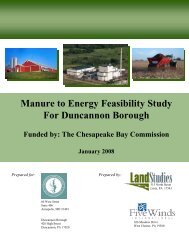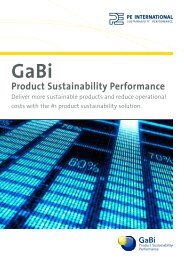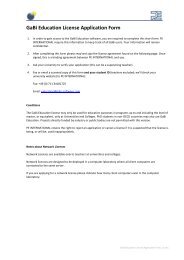Create successful ePaper yourself
Turn your PDF publications into a flip-book with our unique Google optimized e-Paper software.
2012 Transport<br />
DOKUMENTATION TRANSPORTATION PROCESSES<br />
PASSENGER CAR<br />
Content<br />
General Discription of Processes .............................................................................................. 2<br />
Process Characterization / Naming ........................................................................................... 2<br />
Classification into ....................................................................................................................... 2<br />
Vehicle Category, fuel, capacity (cf. [5]) ................................................................................ 2<br />
Emission Category (cf. [5]) .................................................................................................... 2<br />
Road Categories (cf. [5]) ....................................................................................................... 2<br />
Emissions Calculation ............................................................................................................... 3<br />
General Emissions Calculation .............................................................................................. 3<br />
Singularity for CO2 ................................................................................................................. 3<br />
Calculation of SO2 ................................................................................................................. 3<br />
Laughing Gas (N2O) and Ammonia (NH3) ............................................................................. 3<br />
Production and end of life .......................................................................................................... 4<br />
Variable Parameters .................................................................................................................. 4<br />
Inputs ......................................................................................................................................... 4<br />
Valuable Substances ............................................................................................................. 4<br />
Outputs ...................................................................................................................................... 4<br />
Valuable Substances ............................................................................................................. 4<br />
Emissions .............................................................................................................................. 4<br />
Systems and Emissions that are not considered ...................................................................... 5<br />
Application ................................................................................................................................... 5<br />
Process Integration .................................................................................................................... 5<br />
Input Parameters ....................................................................................................................... 5<br />
Sulfur Content of Fuel ............................................................................................................ 5<br />
Driving Shares for Motorway, Rural, Urban (respective parameters: “share_mw”,<br />
“share_ru”, “share_ur”) .......................................................................................................... 5<br />
Driving Performance .............................................................................................................. 5<br />
Representativeness ................................................................................................................... 6<br />
Technological ......................................................................................................................... 6<br />
Spatial .................................................................................................................................... 6<br />
Temporal ................................................................................................................................ 6<br />
Literature ...................................................................................................................................... 6<br />
Process List (<strong>GaBi</strong>) ..................................................................................................................... 7<br />
– 1 / 8 –
General Discription of Processes<br />
2012 Transport<br />
This documentation describes transportation processes for gasoline/diesel driven<br />
passenger cars. The processes comprise the use phase with fuel demand and<br />
emissions released. Production and end of life can be integrated. The default functional<br />
unit is 1 vehicle kilometer.<br />
Process Characterization / Naming<br />
General process naming:<br />
Vehicle category, fuel, capacity, emission category<br />
A list of processes available is added to this document.<br />
Classification into<br />
Vehicle Category, fuel, capacity (cf. [5])<br />
Passenger car gasoline driven 2 l<br />
Passenger car diesel driven 1,4-2 l<br />
Passenger car diesel driven >2 l<br />
Emission Category (cf. [5])<br />
ECE 15'04 (gasoline only) without catalytic converter<br />
non-controlled catalytic converter (gasoline only)<br />
controlled catalytic converter < 87 (gasoline only)<br />
controlled catalytic converter 87-90 (gasoline only)<br />
conventional (gasoline only) other measures (e.g. exhaust gas recirculation)<br />
1986-88 (diesel only)<br />
Euro 1<br />
Euro 2<br />
Euro 3<br />
Euro 4<br />
Euro 5<br />
Road Categories (cf. [5])<br />
Average Motorway (MW)<br />
Average Rural (RU)<br />
Average Urban (UR)<br />
– 2 / 8 –
Emissions Calculation<br />
2012 Transport<br />
The emission calculations are derived from emission factors from literature (HBEFA) [5]<br />
which are based on measurements. Additional calculation principles are elucidated<br />
below.<br />
General Emissions Calculation<br />
The total emissions for each pollutant are to be calculated based on emission factors<br />
(EM) by road category (Motorway = MWEm, Rural = RUEm, Urban = UREm) taken from<br />
literature in [g/km] and share of road categories (Motorway = MWshare, Rural = RUshare,<br />
Urban = URshare) [-] berechnet:<br />
Emission<br />
<br />
Emission<br />
MWshare MWEM<br />
RU share RU EM URshare<br />
UREM<br />
km <br />
<br />
X (1)<br />
Singularity for CO2<br />
The calculations for carbon dioxide emissions are based on the emission factors<br />
according to equation (1), whereas a constant relation of 3.175 kgCO2/ kgfuel for the fuel<br />
consumption is assumed.<br />
Gasoline: with a medium density of 0.742 kg/l; this is equal to a ratio of<br />
2.356 kgCO2/lgasoline<br />
Diesel: with a medium density of 0.832 kg/l; this is equal to a ratio of<br />
2.642 kgCO2/ldiesel.<br />
Calculation of SO2<br />
For sulfur dioxide, a complete stoichiometric conversion of the sulfur contained in the<br />
fuel and of oxygen into SO2 is assumed. The sulfur content in the fuel is a variable<br />
parameter, which can be set individually by the user.<br />
S + O2 → SO2<br />
EF<br />
SO<br />
x _ ppmS<br />
kg<br />
<br />
1 000 000 kg<br />
64g<br />
<br />
32g<br />
kg<br />
Diesel_Consumption<br />
kg<br />
– 3 / 8 –<br />
g<br />
<br />
kg<br />
<br />
<br />
kg<br />
_ 2<br />
S<br />
SO2<br />
Diesel SO2<br />
(2)<br />
Diesel S<br />
Cargo<br />
Cargo<br />
EF_SO2<br />
x_ppms<br />
Emission factor for SO2<br />
Mass share of sulfur in fuel<br />
Laughing Gas (N2O) and Ammonia (NH3)<br />
The emission factor for laughing gas (nitrous oxide, N2O) is assumed to be constant for<br />
each emission category and each road category. The emission factor for ammonia<br />
(NH3) is set as constant throughout all categories.
Production and end of life<br />
2012 Transport<br />
Production and of life are not part of the passenger car process though a model<br />
specific integration is intended into input and output. The scaling results from 1/km<br />
driving performance to the unit of 1 vehicle kilometer.<br />
Variable Parameters<br />
Parameter Name Comment Unit<br />
share_MW Driving Share on Motorway (MW) -<br />
share_RU Driving Share Rural (RU) -<br />
share_UR Driving Share Urban (UR) -<br />
share_CO2_bio Share of Biogenic C in Fuel -<br />
driving performance life-time Mileage of Vehicle km<br />
ppm_sulfur Mass Share of Sulfur in Fuel ppm<br />
Inputs<br />
Valuable Substances<br />
Flow Flow Group Unit<br />
Gasoline/Diesel Crude Oil Products kg<br />
Vehicle Material Systems pcs<br />
Outputs<br />
Valuable Substances<br />
Flow Flow Group Unit<br />
Vehicle Kilometers Others 1000m<br />
Vehicle Material Systems pcs<br />
Emissions<br />
Flow Flow Group Unit<br />
Ammonia Inorganic Emissions to Air kg<br />
Benzene Group NMVOC to Air kg<br />
Carbon Dioxide Inorganic Emissions to Air kg<br />
Carbon Dioxide (biotic) Inorganic Emissions to Air kg<br />
Carbon Monoxide Inorganic Emissions to Air kg<br />
Dust (PM2.5) Particles to Air kg<br />
Methane Organic Emissions to Air (Group VOC) kg<br />
Nitrogen Dioxide Inorganic Emissions to Air kg<br />
– 4 / 8 –
2012 Transport<br />
Flow Flow Group Unit<br />
Nitrogen Monoxide Inorganic Emissions to Air kg<br />
Nitrous Oxide (Laughing Gas) Inorganic Emissions to Air kg<br />
NMVOC (unspecific) Group NMVOC to Air kg<br />
Sulfur Dioxide Inorganic Emissions to Air kg<br />
Systems and Emissions that are not considered<br />
Vehicle production (integration optional where required)<br />
Vehicle recycling (integration optional where required)<br />
Infrastructure (roads/...)<br />
Noise<br />
Diurnal losses and refueling losses (see [6])<br />
Hot-Soak-Emissions<br />
Oil use<br />
Cold-Start Emissions<br />
Emissions from air conditioning (relevance < 1 %, see [4])<br />
Abrasion of tyres and brakes<br />
Application<br />
Process Integration<br />
The passenger car process is integrated into the model by the flow „vehicle kilometers“.<br />
Input Parameters<br />
The truck processes can be adapted to specific conditions by means of the variable<br />
parameters.<br />
Sulfur Content of Fuel<br />
The sulfur content in diesel fuel varies strongly worldwide; the transport processes can<br />
be adapted accordingly.<br />
Average sulfur contents for example: EU = 10 ppm [2].<br />
Driving Shares for Motorway, Rural, Urban (respective parameters:<br />
“share_mw”, “share_ru”, “share_ur”)<br />
The driving shares for Motorway (MW), Rural (RU), Urban (UR) can be adapted to<br />
specific boundary conditions. The predefined standard values represent the shares for<br />
Germany for the respective vehicle. In addition, the shares must be 1 total.<br />
Driving Performance<br />
The parameter „driving performance“ is necessary to scale production and end of life.<br />
In case neither production nor end of life is considered ( this means the respective<br />
processes are not connected) the parameter remains constant.<br />
– 5 / 8 –
Representativeness<br />
Technological<br />
2012 Transport<br />
The standard emission classes are covered by different datasets. The technologies are<br />
representative Europe-wide and can be adapted for worldwide locations with some<br />
minor restrictions. There is a need to identify the corresponding emission classes.<br />
Spatial<br />
The reference locations are Germany, Austria and Switzerland. However due to the<br />
similarity of the vehicle structures and the same emissions limit values, the models are<br />
representative for the entire EU. The model can be adjusted to conditions in other<br />
countries worldwide with only some minor uncertainties. Note: impreciseness increases<br />
with the increase of deviation of the vehicle structure and with the road categories and<br />
the utilisation behavior – these can be adapted by modifying the driving share<br />
(MW/RU/UR) as well as the utilisation ratio and sulfur content in the fuel for individual<br />
conditions.<br />
Temporal<br />
The reference year of the data sets is 2010; representativeness may be assumed for<br />
the period of 2010 to 2015.<br />
Modification of the age structure of vehicles for each emission class leads to changes<br />
in the emission profile. The validity of the data set is given for about 5 years (until<br />
2015). Prognoses in HBEFA [5] based on comprehensive time series (1994-2020)<br />
report that there is no change in emission profiles within a certain size class, emissions<br />
class or road category. Only the different composition of a total vehicle fleet results in<br />
some changes between 2010 and 2015.<br />
Literature<br />
[1] EUROPEAN PARLIAMENT AND THE COUNCIL OF THE EUROPEAN UNION:<br />
Directive 1999/96/EC of the European Parliament and of the Council of 13<br />
December 1999 on the approximation of the laws of the Member States relating<br />
to measures to be taken against the emission of gaseous and particulate<br />
pollutants from compression ignition engines for use in vehicles, and the emission<br />
of gaseous pollutants from positive ignition engines fuelled with natural gas or<br />
liquefied petroleum gas for use in vehicles and amending Council Directive<br />
88/77/EEC. Brussels, Official Journal L 044, 16/02/2000 P. 0001 – 0155.<br />
[2] EUROPEAN PARLIAMENT AND THE COUNCIL OF THE EUROPEAN UNION:<br />
Directive 2003/17/EC of the European Parliament and of the Council of 3 March<br />
2003 amending Directive 98/70/EC relating to the quality of petrol and diesel<br />
fuels. Brussels, Official Journal of the European Union L76/10, 22/03/2003.<br />
[3] EUROPÄISCHE UNION: EUROPA – Environment – Auto-Oil II Programme.<br />
http://ec.europa.eu/environment/archives/autooil/index.htm<br />
– 6 / 8 –
2012 Transport<br />
[4] SCHWARZ, Dr. Winfried; LEISEWITZ, Dr. André: Emissionen und<br />
[5]<br />
Minderungspotential von HFKW, FKW und SF6 in Deutschland, Im Auftrag des<br />
Umweltbundesamtes, Forschungsbericht 29841256, Frankfurt, 1999.<br />
Umweltbundesamt Berlin; BUWAL / OFEFP Bern; Umweltbundesamt Wien:<br />
Handbuch Emissionsfaktoren des Straßenverkehrs, Version 3.1,<br />
http://www.hbefa.net, Berlin, Bern, Vienna / Germany, Switzerland, Austria, 2010.<br />
[6] UMWELTLEXIKON: Umweltlexikon: Betankungsverlust.<br />
http://www.umweltlexikon-online.de/RUBluft/Betankungsverlust.php<br />
Process List (<strong>GaBi</strong>)<br />
The following processes for passenger cars are avaliable:<br />
region standard emission standard type engine size<br />
GLO gasoline driven ECE 15'04 technology mix engine size up to 1,4l<br />
GLO gasoline driven non-controlled catalytic converter technology mix engine size up to 1,4l<br />
GLO gasoline driven controlled catalytic converter < 87 technology mix engine size up to 1,4l<br />
GLO gasoline driven controlled catalytic converter 87-90 technology mix engine size up to 1,4l<br />
GLO gasoline driven conventional technology mix engine size up to 1,4l<br />
GLO gasoline driven Euro 1 technology mix engine size up to 1,4l<br />
GLO gasoline driven Euro 2 technology mix engine size up to 1,4l<br />
GLO gasoline driven Euro 3 technology mix engine size up to 1,4l<br />
GLO gasoline driven Euro 4 technology mix engine size up to 1,4l<br />
GLO gasoline driven Euro 5 technology mix engine size up to 1,4l<br />
GLO gasoline driven ECE 15'04 technology mix engine size 1,4-2l<br />
GLO gasoline driven non-controlled catalytic converter technology mix engine size 1,4-2l<br />
GLO gasoline driven controlled catalytic converter < 87 technology mix engine size 1,4-2l<br />
GLO gasoline driven controlled catalytic converter 87-90 technology mix engine size 1,4-2l<br />
GLO gasoline driven conventional technology mix engine size 1,4-2l<br />
GLO gasoline driven Euro 1 technology mix engine size 1,4-2l<br />
GLO gasoline driven Euro 2 technology mix engine size 1,4-2l<br />
GLO gasoline driven Euro 3 technology mix engine size 1,4-2l<br />
GLO gasoline driven Euro 4 technology mix engine size 1,4-2l<br />
GLO gasoline driven Euro 5 technology mix engine size 1,4-2l<br />
GLO gasoline driven ECE 15'04 technology mix engine size more than 2l<br />
GLO gasoline driven non-controlled catalytic converter technology mix engine size more than 2l<br />
GLO gasoline driven controlled catalytic converter < 87 technology mix engine size more than 2l<br />
GLO gasoline driven controlled catalytic converter 87-90 technology mix engine size more than 2l<br />
GLO gasoline driven conventional technology mix engine size more than 2l<br />
GLO gasoline driven Euro 1 technology mix engine size more than 2l<br />
GLO gasoline driven Euro 2 technology mix engine size more than 2l<br />
GLO gasoline driven Euro 3 technology mix engine size more than 2l<br />
GLO gasoline driven Euro 4 technology mix engine size more than 2l<br />
GLO gasoline driven Euro 5 technology mix engine size more than 2l<br />
GLO diesel driven 1986-88 technology mix engine size up to 1,4l<br />
– 7 / 8 –
2012 Transport<br />
GLO diesel driven Euro 1 technology mix engine size up to 1,4l<br />
GLO diesel driven Euro 2 technology mix engine size up to 1,4l<br />
GLO diesel driven Euro 3 technology mix engine size up to 1,4l<br />
GLO diesel driven Euro 4 technology mix engine size up to 1,4l<br />
GLO diesel driven Euro 5 technology mix engine size up to 1,4l<br />
GLO diesel driven 1986-88 technology mix engine size 1,4-2l<br />
GLO diesel driven Euro 1 technology mix engine size 1,4-2l<br />
GLO diesel driven Euro 2 technology mix engine size 1,4-2l<br />
GLO diesel driven Euro 3 technology mix engine size 1,4-2l<br />
GLO diesel driven Euro 4 technology mix engine size 1,4-2l<br />
GLO diesel driven Euro 5 technology mix engine size 1,4-2l<br />
GLO diesel driven 1986-88 technology mix engine size more than 2l<br />
GLO diesel driven Euro 1 technology mix engine size more than 2l<br />
GLO diesel driven Euro 2 technology mix engine size more than 2l<br />
GLO diesel driven Euro 3 technology mix engine size more than 2l<br />
GLO diesel driven Euro 4 technology mix engine size more than 2l<br />
GLO diesel driven Euro 5 technology mix engine size more than 2l<br />
– 8 / 8 –




